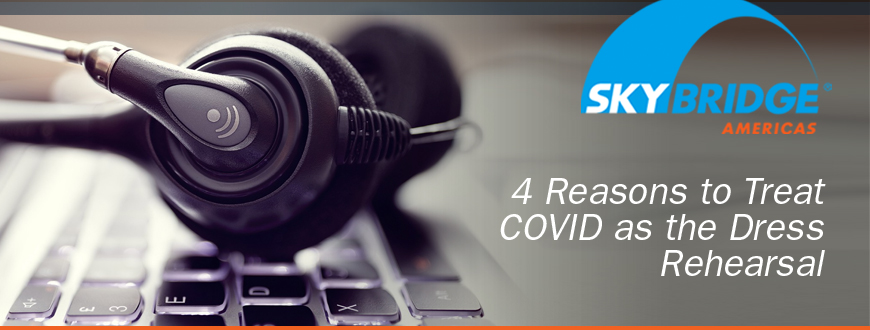
How the lessons you learn now will make your brand stronger and better prepared for the next unknown
If you haven’t taken the time yet to step back from today’s challenge to plan for the next one, you’d be forgiven. But in his recent article for Forbes, writer and consultant, Stephen Wunker, makes a compelling argument for doing so – and starting now.
As he argues convincingly for “Scenario Planning,” Wunker points to the reality that just about every customer contact center has been living since March of this year:
“While some were poised to respond to the turbulence that coronavirus introduced to business environments, most were not.”
I say “just about every customer contact center” because there were a handful of customer care providers – Skybridge Americas included – who were ready. The truth is, most call center operations were larger on-site. When COVID forced them to shut down those brick and mortar centers and hustle to get agents set up from at-home work desks, their customers – and their employees — suffered the consequences. In the meantime, at Skybridge Americas, our customer care agents were already delivering superior, seamless CX from the safety of their own home workspaces.
As I read Wunker’s article, I was particularly struck by his 2nd piece of advice: “Separate what you know from what you don’t know.” But, after my experience with long-term customers, new customers, even competitors, I would add a thought: “Separate your in-house expertise from expertise you may be better served by outsourcing.”
You can read it here. As he suggests, it may bring about some discomfort – but that’s the first step in planning changes for the better. If you would like to know more about how Skybridge Americas can help you prepare to deliver superior, seamless CX, please reach out. We would love to talk!
Learning From Covid: How To Use Scenario Planning To Prepare For Future Uncertainty
Stephen Wunker
Leading up to 2020, executives were already grappling with rising disruptive technologies, changing business models, and rivals emerging from unexpected places. Throw in a global pandemic, and the future seems about as predictable as a game of Rock, Paper, Scissors with a hundred hands.
While some were poised to respond to the turbulence that coronavirus introduced to business environments, most were not. Traditional approaches to strategic planning have largely been unsuited to Covid times and have left companies vulnerable. So, what are businesses to do in an environment changing so quickly that strategic plans end up getting thrown out the window?
Enter scenario planning, a form of planning that leverages what you don’t know to bring multiple hypothetical futures into view. Scenario planning allows you to:
- Gain insight into the key drivers of a situation
- Embrace and control uncertainty
- Recognize the assumptions your organization has been making
- Expose your false sense of security
Sound uncomfortable? Good! Scenario planning isn’t new, but it is newly relevant in the age of coronavirus and beyond. Some industries and businesses have already adopted scenario planning for Covid—if you’re in any way connected to a college or university, you’ve likely received an email from the administration detailing the potential options for coming back to campus in the 2020-2021 academic year. Macalester College in St. Paul, Minnesota, for example, distributed a list of six scenarios in early May. Each scenario proposes slight variations on the structure of the school year (e.g., semesters, “blocks,” trimesters), how many classes each faculty member will teach, and when the community will return to campus, all with the goal of having as much in-person learning as possible.
Scenario planning is an invaluable tool if you’re trying to determine what the future might look like for your business. While the coronavirus has ramped up our understanding of uncertainty to the extreme, companies will always grapple with blind spots and unknowns. Here are five steps you can take to prepare your business for unknowns beyond the pandemic:
- Identify the trends affecting your business
What are the major factors affecting how your business functions and how your customers are making decisions? The PESTLE framework helps identify relevant trends both internally and externally. For example, environmental trends in healthcare could be interpreted literally (e.g., pollution patterns), or more broadly in terms of trends that could affect the market (e.g., aging populations in Europe). Combine the two approaches to trend identification and you’ll get a more holistic view of what’s relevant to you and how changes in the world might affect your business.
- Separate what you know from what you don’t know
Identify the assumptions you’re making and expose your major blind spots. Interviewing key stakeholders to uncover how they envision the future of the business might help expose where some of these assumptions lie. Determine your commonly accepted “truths” and rigorously challenge them—maybe some of these “truths” are actually unknowns.
READ the entire article here >
-Bobby Matthews
Senior Vice President, Sales and Marketing
Skybridge Americas
bmatthews@skybridgeamericas.com
Find out how Skybridge Americas can help you delight your customers and grow your business.
We seamlessly integrate our superior customer care skills with your brand messaging. For more information, contact us at 763-299-4570 or submit our contact form.

